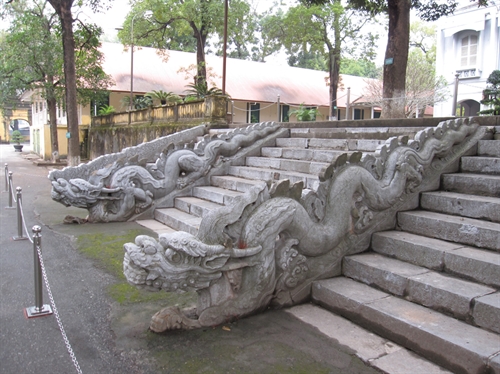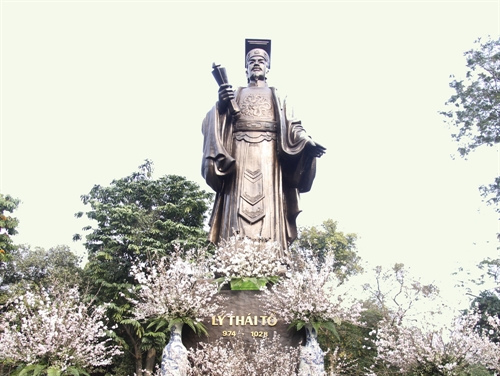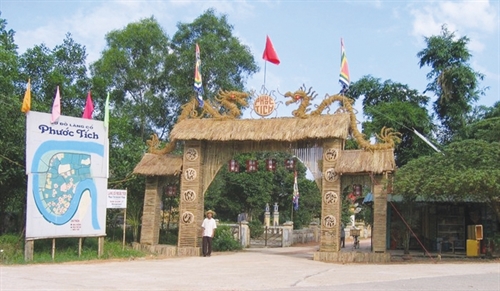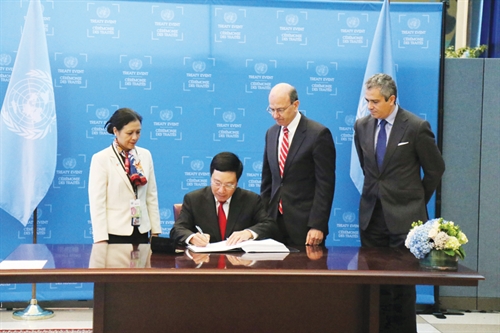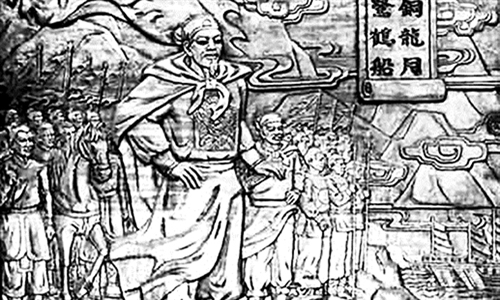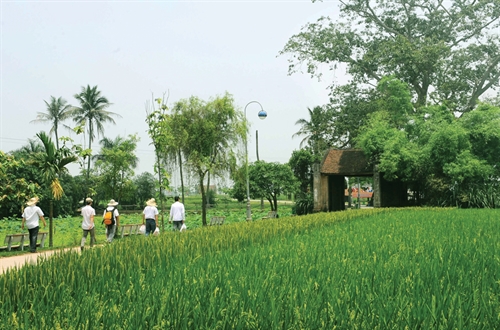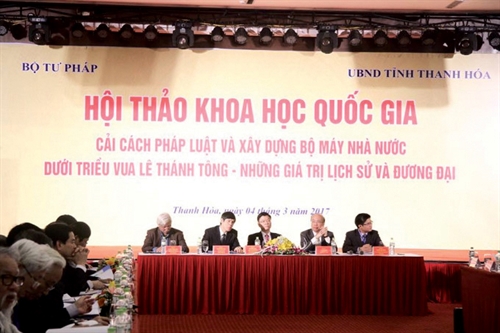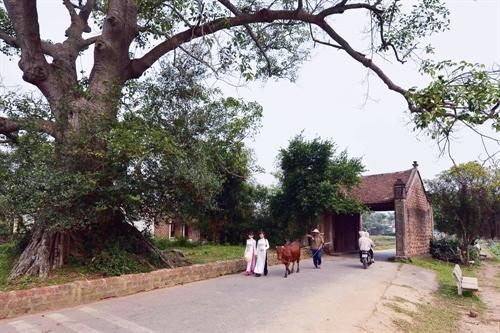Associate Professor Dr. Tran Thi Vinh
Institute of History
After moving the capital to the land of Thang Long (present-day Hanoi), the Ly dynasty (1010-1225) immediately paid attention to building a mandarinate system in its own way. The Ly kings, on the one hand, quickly aristocratized the Ly descent and, on the other hand, employed courtiers with eminent service and started training Confucian scholars for the state apparatus.
The mandarin recruitment during the Ly dynasty was conducted mainly in three ways: “tuyen cu” (nomination-based recruitment), “nhiem tu” (recruitment of mandarins’ offspring) and “khoa cu” (examination-based recruitment). In addition, a new way was also used, that was “nop tien” (money payment). In his book titled “Lich trieu hien chuong loai chi” (Regulations of Successive Dynasties), historian Phan Huy Chu wrote: “Under the Ly dynasty, when examinations for public office were not regularly organized yet, the recruitment of mandarins was implemented primarily through nomination-based recruitment, recruitment from mandarins’ offspring and money payment.”[1]
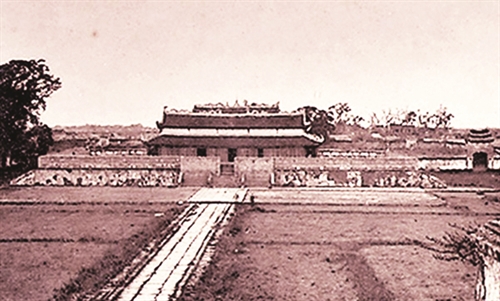 |
| Thang Long Imperial Citadel__Photo: Internet |
Nomination-based recruitment
During its early days, besides employing former mandarins of the previous Le dynasty, the Ly dynasty attached great importance to the method of nomination-based recruitment to choose mandarins for the royal court. Although this method was not described in detail in any historical books, one certain thing is that the nominees came from the upper class. According to Lich trieu hien chuong loai chi: “Children of toiling people, singers and slave servants were not named in the list of nominees.”[2] After the establishment of “Van Mieu - Quoc Tu giam” (the Temple of Literature - the National University) in 1076, King Ly Nhan Tong started selecting people with virtue and talent to take care of military and civilian affairs and recruited literate persons into Quoc Tu giam.[3] Yet, earlier, in order to strengthen the state apparatus, King Ly Thai To had to resort to the method of nomination to recruit mandarins from his relatives and people with meritorious service. Phan Huy Chu wrote in Lich trieu hien chuong loai chi: “The Ly dynasty bestowed royal titles on royal relatives and people with meritorious service.”[4]
Right after ascending to the throne, King Ly Thai To conferred the royal title of “Vuong” on his children and relatives, such as Crown Prince Phat Ma as Khai Thien Vuong, Prince Bo as Khai Quoc Vuong, Prince Luc as Dong Chinh Vuong and other princes as Duc Thanh Vuong and Vu Uy Vuong, and allowed them to have their own palaces. His 13 princesses were all assigned to manage different taxes according to their ranks[5]. The king also conferred the title on his elder brother and uncle respectively as Vu Uy Vuong and Vu Dao Vuong.[6]
With the regime of nomination-based recruitment from the royal rank, many members of the Ly descent held their key positions in the royal court for a long time such as Ly Dao Thanh working as “Te tuong” (Prime Minister) for several decades under the reigns of King Ly Thanh Tong and King Ly Nhan Tong; and Ly Cong Binh holding the same position also for tens of years from the reign of King Ly Anh Tong to the reign of King Ly Cao Tong.
Many persons who did not bear the Ly family name were aristocratized thanks to their great service to the kings and the royal court. For example, Ly Thuong Kiet, a brilliant general under the Ly dynasty, had his real name of Ngo Tuan. Phi Cong Tin was permitted to be renamed as Ly Cong Tin after he was promoted to the position of “Ta ty lang trung”[7]. Do Kinh Tu, a resident of Van Canh district (Tu Liem, Hanoi), was renamed as Ly Kinh Tu after being promoted to the Binh tao position, acting as an assistant to King Ly Anh Tong; in 1184 he was conferred the title of “de su”[8] (teacher of the king). Mau Du Do, who rendered great service to King Ly Than Tong, was promoted to be “Giam nghi dai phu”[9] then allowed to bear the royal Ly family name.
Together with the acristocratization of the Ly descent, the Ly kings also thought highly of maternal relatives, appointing relatives of the queens to key positions in the royal court. In 1028, King Ly Thai Tong appointed Queen Mai’s father to be “An quoc thuong tuong” or Queen Vuong’s father to be “Phu quoc thuong tuong”, or Queen Dinh’s father to be “Khuong quoc thuong tuong”[10].
The Ly dynasty also employed courtiers with meritorious service right in its early days of building the monarchy. For instance, Dao Cam Moc was conferred the title of “Tin Nghia hau” and married to Princess Truong; or Tran Cao was given the title of “Tuong cong”, Ngo Dinh as “Khu mat su”, Dao Thac Phu as “Thai bao”, Dang Van Hieu as “Thai pho”, etc.[11] This was recorded in Lich trieu hien chuong loai chi: “Ly Thai To, in his first reign year of Thuan Thien (1010), conferred mandarin titles to relatives and persons with meritorious service to the court, holding such positions as “Thai su”, “Thai pho”, “Thai bao”, “Tong quan”, “Tuong cong”, “Co mat su”, “Ta huu kim ngo”, “Ta huu vu ve” and ”Vien ngoai lang”[12].
Under King Ly Thai Tong’s reign, close and reliable subjects were also put in important positions. For example, Le Phung Hieu, who had defeated rebels and successfully protected King Ly Thai Tong’s throne, was appointed to the position of “Do thong thuong tuong quan”[13]. Ly Nhan Nghia, who joined Le Phung Hieu in suppressing the rebellions, was appointed to the positions of “Huu phuc tam” then “Kinh su” in 1028.[14] In the same year, the King promoted and conferred royal titles on many close subjects such as Luong Van Nham as “Thai su”, Ngo Thuong Dinh as “Thai pho”, Dao Xu Trung as “Thai bao”, Ly Dao Ky as “Ta khu mat”, Ly Trieu as “Thieu su”, and Xung Tan as “Huu khu mat”[15].
The conferment of royal titles on people with meritorious service continued in subsequent years of the Ly dynasty. In 1128, after ascending to the throne, King Ly Than Tong conferred royal titles on many courtiers such as Le Ba Ngoc as “Thai uy” (a high-ranking military mandarin); Luu Ba and Duong Anh Nhi as “Thai pho”; Mau Du Do as “Giam nghi dai phu”; and Ly Khanh, Nguyen Phuc and Cao Y as “Thai bao”[16].
With such a broad nomination-based recruitment regime, the number of mandarins added to the state apparatus in the Ly dynasty considerably increased. Yet, to recruit more mandarins and to give more privileges to bureaucratic aristocrats, the Ly dynasty additionally maintained the recruitment of mandarins’ offspring previously applied by the Dinh and Early Le dynasties.
Recruitment of mandarins’ offspring
Recruitment of children of mandarins had been applied previously by the Dinh and Early Le dynasties and was maintained by the Ly kings. However, this way of recruiting mandarins was not specifically mentioned in any historical books as recorded by Phan Huy Chu in Lich trieu hien chuong loai chi: “From the Tran dynasty backward, mandarin titles conferred to courtiers’ children cannot be inquired..., the conferment of military and civilian mandarin titles to mandarins’ children cannot be inquired, either.”[17] However, this regime was certainly not as highly valued by the Ly dynasty as by the two previous ones because it could not ensure the quality of mandarins in the new situation and especially created more privileges for bureaucratic aristocrats while hampering the building of a contingent of knowledgeable and capable mandarins to serve the country. For such inadequacy, the Ly dynasty started thinking of developing examinations to recruit virtuous and talented scholars to be mandarins so as to ensure the survival of the monarchy. Therefore, examinations were considered the second important method of mandarin recruitment by the Ly dynasty. Yet, pending the development of examinations, the Ly kings applied another recruitment method called “nop tien”, namely payment of money, for appointment of mandarin positions.
Money payment
Money payment for appointment of mandarin positions was not surely common as in the subsequent dynasties. Therefore, specific money amounts and mandarin positions were not mentioned in any historical records. It was only mentioned in Lich trieu hien chuong loai chi that: The money payer was initially appointed to be Lai (civil servant); for the second payment, he was appointed to be “Thua tin lang” (a low-ranking military mandarin); and those who recorded achievements in work were appointed to be “tri chau” (district head)[18].
 |
| A court session in feudal times__Photo: Internet |
Examinations
Examinations to select educated talents started from the Ly dynasty. For the first time in the history of Vietnamese monarchies, examinations were mentioned in old historical records as follows: In the second lunar month of the year of At Mao (1075), the King issued an edict to recruit “Minh kinh bac hoc” (the first laureate) and organize Confucian examinations at three levels. Le Van Thinh passed the examinations and was recruited as the king’s teacher[19]. The book titled “Viet su thong giam cuong muc” stressed: “Examinations in our country began from then on” and “Le Van Thinh was the first graduate.”[20]
Since then, Confucianism was highly valued and successful Confucian candidates started to join the state administration. However, under the Ly dynasty, examinations did not become regular yet and nomination-based recruitment was still maintained. One year after the first examination, in 1076 the Ly royal court had to issue an order to “promote virtuous and talented people to administer military and civilian affairs” and “to select literate mandarins for Quoc Tu giam”[21]. In the second lunar month in the spring of 1077, the royal court organized the second examination, called Lai vien, in letter-writing art, math calculations and criminal law. Those who passed the examination were employed[22]. Nine years later, in 1086, the third examination was held to recruit literate persons to work in “Han lam vien” (Academy), an important body assisting the kings. Mac Hien Tich, who passed this examination with the highest score, was appointed as “Han lam hoc si”[23], heading the Academy. The fourth and fifth examinations were organized in 1152 and 1165, respectively. Those who passed these two examinations were not recorded in historical books. The sixth examination took place 20 years later, in 1185, with 30 successful candidates, including Bui Quoc Khai (from Cam Giang district, Hai Duong province) and Dang Nghiem (from Thu Tri, Thai Binh province)[24]. Eight years later in 1193, the Ly dynasty organized the examination to again select literate people to assist the king in study[25]. The last examination organized in 1195[26] by the Ly dynasty was on “Tam giao” (three religions: Confucianism, Buddhism and Taoism). Those who passed the examination were all appointed to be mandarins.
During 215 years of existence, the Ly dynasty organized just nearly 10 examinations not on a regular basis but only when it found necessary. The exact number of Confucian scholars who passed these examinations and worked for the state administration of the Ly dynasty remains unknown today but surely it was very modest.
It is obvious that the Ly dynasty started to develop academic studies and organize examinations to recruit mandarins. However, the still small number of mandarins recruited by this method as compared to the numbers of mandarins recruited through nomination and from mandarins’ offspring shows that this method of recruitment did not occupy an important position during that time. Only in the subsequent dynasties, did it become a major recruitment method.
Besides, the Ly dynasty held tests of incumbent mandarins for the first time in 1051 in order to heighten the capability and qualities of mandarins working in the royal court, through which “military and civilian mandarins who do not commit mistakes or crimes will be promoted...”[27] In 1097, after holding a nomination-based recruitment of mandarins, King Ly Nhan Tong still ordered mandarins “to review and revise former regulations before promulgation and implementation”[28]. In 1162, King Ly Anh Tong again ordered to hold tests of military and civilian mandarins for promotion. From that year on, tests were conducted regularly once every nine years[29]. In 1179, King Ly Cao Tong classified mandarins into three types based on their merits: (a) Those who worked industriously but were not knowledgeable; (b) those who were knowledgeable and talented; and (c) those who are senior, virtuous and knowledgeable. All of these mandarins were appointed to corresponding posts to rule people or command the army. Such tests helped “prevent mandarins from power abuse and corruption”[30]. Under the reign of King Ly Cao Tong, these tests were still held until 1193.[31]
Yet, since their interval was too long, these tests were not the best measure to raise the quality of mandarins. “If the promotion or demotion of mandarins is so prolonged, the people with virtue and talent will have no chance to develop while those without talent can temporarily survive.”[32] Phan Huy Chu also remarked in his book “Lich trieu hien chuong loai chi” that “the test interval in the Ly and Tran dynasties was too long.”[33] These tests, though useful, surely yielded limited effectiveness.
With three methods of mandarin recruitment and the test regime mentioned above, the Ly dynasty managed to build a fairly large contingent of mandarins working in the state apparatus from the central to local levels, including aristocrats, courtiers and Confucian scholars. Besides, following the previous dynasties, the Ly dynasty also employed veteran bonzes of high virtues, also called bonze mandarins, to manage Buddhist monks and nuns in the country.
Thanks to a fairly regular recruitment regime and a strict test regime, the quality of mandarins under the Ly dynasty was undoubtedly good, thus helping the Ly kingdom exist for more than two centuries. This contributed to the vigorous development of the Dai Viet (Great Viet) nation during that period with strong economic development, firm national defense and Thang Long culture deeply imbued with historical imprints.-
